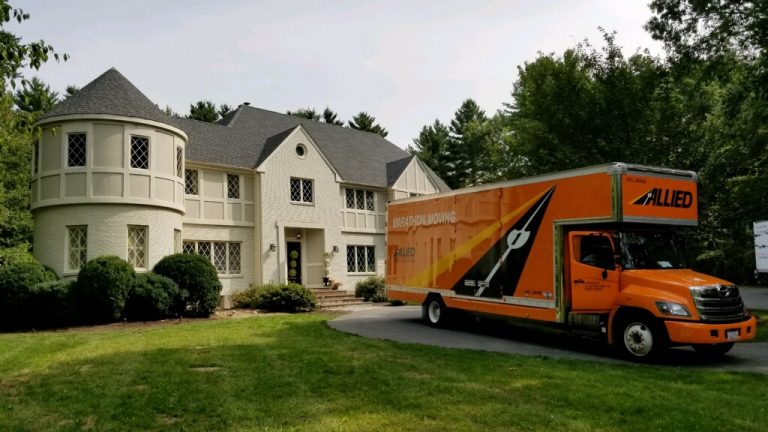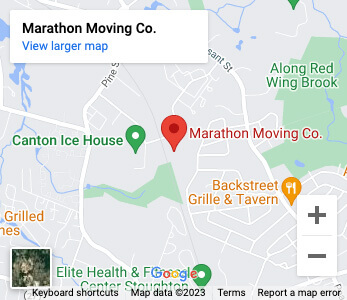We'll Move You Every Step Of The Way

Welcome to Marathon Moving
We’re A Local Dover Massachusetts Moving Company With A Verifiable Reputation For Quality!
There are about 6,279 residents in the Town of Dover Massachusetts. It is only about 15 miles southwest of downtown Boston and easy access to just about anywhere in the state. Dover is a residential town nestled on the south banks of the Charles River.
Dover is an extremely beautiful place to be moving to. However, whenever you’re moving to Dover you will find that the town is better than you expected. Dover is in Norfolk County and is one of the best places to live in Massachusetts. Living in Dover offers residents a rural feel and most residents own their homes. In Dover there are a lot of parks to enjoy and relax.
Another tip that Dover movers should keep in mind that they will be moving into or out of an expensive home. Because of this, you need to ensure that the moving company in Dover that you choose is properly insured and does proper background screening in it’s employees. You should also be sure that the moving company you choose is used to handling and moving high value moves. Contact our Dover Movers for a quick moving quote.
Marathon Moving Company, based in Dover, New Hampshire, is a premier provider of comprehensive moving services. With over 20 years of experience and more than 40,000 successful residential and commercial moves, we have established ourselves as the trusted choice for individuals and businesses seeking reliable and professional movers in Dover, NH.
Our Services
At Marathon Moving Company, we offer a wide range of services tailored to meet the unique needs of our clients. Our offerings include:
As local movers in Dover, we understand the intricacies of relocating within the community. Whether you’re moving across the street or to a neighboring town, our team ensures a smooth and efficient transition.
Planning a move beyond New Hampshire? Our interstate moving services provide seamless relocations across state lines. We handle all aspects of the move, ensuring your belongings arrive safely at your new destination.
Embarking on a cross-country move can be daunting. Our experienced team manages the complexities of long-distance relocations, offering peace of mind as you settle into your new home, no matter the distance.
Proper packing is crucial for a successful move. We offer professional packing services and high-quality supplies to protect your belongings during transit. Our team is trained in handling items of all sizes and fragility levels.
Need a place to store your items during the moving process? We provide secure storage solutions for both short-term and long-term needs. Our facilities are equipped to safeguard your possessions until you’re ready to move them into your new space.
Relocating a business requires meticulous planning and execution. Our corporate relocation services minimize downtime and ensure a seamless transition for your company, employees, and assets.
Moving abroad introduces unique challenges. We offer comprehensive international moving services, managing logistics and customs to make your overseas relocation as smooth as possible.
Long-Distance Moving
Whether you’re moving to a neighboring state or across the country, our long-distance moving services are designed to handle the complexities of extended relocations, ensuring timely and safe delivery of your belongings.
Moving your household involves more than just transporting items; it’s about transitioning your life. We treat your possessions with the utmost care, ensuring everything from your furniture to personal items arrives intact and on time.
Our Moving Process
We believe that a well-structured moving process is key to a successful relocation. Our approach includes:
1. Initial Consultation:
- We begin with a thorough assessment of your moving needs, discussing timelines, special requirements, and any concerns you may have.
2. Customized Moving Plan:
Based on the consultation, we develop a tailored moving plan that outlines every detail, ensuring clarity and alignment with your expectations.
3. Packing and Preparation:
Our professional team uses high-quality materials and techniques to pack your belongings securely, labeling each box for organized unpacking.
4. Loading and Transportation
We handle the heavy lifting, loading your items with care onto our well-maintained moving trucks. Our drivers are experienced in navigating routes efficiently to ensure timely delivery.
5. Unloading and Unpacking:
Upon arrival, we unload and, if desired, unpack your items, placing them in designated areas to help you settle into your new space quickly.
6. Post-Move Support:
Our commitment doesn’t end once the move is complete. We’re available to address any post-move questions or concerns, ensuring your complete satisfaction.
Why Choose Marathon Moving Company?
- Trusted Reputation: Endorsed by MovingScam.com and holding an A+ rating with the Better Business Bureau, our track record speaks to our reliability and professionalism.
- Experienced Team: Our skilled professionals are trained to handle moves of all sizes and complexities, ensuring your belongings are in capable hands.
- Comprehensive Services: From local to international moves, packing to storage, we offer a full suite of services to meet your moving needs.
- Customer-Centric Approach: We prioritize your satisfaction, tailoring our services to align with your specific requirements and preferences.
For a stress-free moving experience with a company that values professionalism and customer satisfaction, contact Marathon Moving Company at 781-650-4952 or visit our website to request a free quote.

What sets Marathon Moving Company apart?
Our company is one of many movers In Dover MA, but our commitment to excellence has put us at the top of the list.

Trusted
Endorsed by MovingScam.com as a trusted mover because of overwhelming positive reviews

Experienced
In business for over 20 years, completing over 40,000 residential/commercial moves.

Recognized
Winner of the distinguished 2013 Best of Boston Award from Boston Magazine.

Consistent
9 straight Super Service Awards from Angie’s List.
Marathon's Quality Moving Standards
We want to make moving easier for everyone by establishing trust between customers and movers. We want to be transparent with you about the standards we set for ourselves and our movers. This will help us communicate our values and guide our behavior. Marathon Moving is committed to the top industry standards and strives to uphold them.
- Security
- Respect
- Reliability
- Transparency
- Professionalism

Our Resources
Additional Moving Resources
We know that moving is stressful enough. To make it as simple and painless as possible, we have provided additional resources to help you.
Let's Get You A Free Quote
For more information on moving to the wonderful town of Dover Massachusetts, Contact Marathon Moving 781-650-4952 for a quick and free estimate.
Contact
Information
Hours Operations
8:00 AM to 5:00 PM – Monday to Friday
Office Closed – Saturday to Sunday
Marathon Moving Co.
146 Will Drive
Canton, Massachusetts 02021
781-650-4952
View Map and Directions »
Phone:781-650-4952
Fax: 781-963-3398
info@marathonmoving.com
© Copyright 2000 – Marathon Moving – Sitemap




